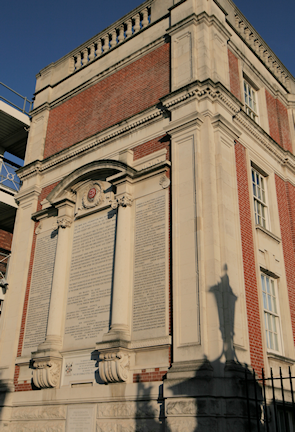Fulham Road
Fulham Road, Hammersmith & Fulham/Kensington & Chelsea
A fashionable street extending two-and-a-half miles south-westwards from Brompton Cross to the grounds of Fulham Palace

The ‘way from Fulham to London’ was first mentioned in 1372 and it became a functional highway in 1410, when the Bishop of London caused Stamford Bridge to be built across Counters Creek, thus connecting Chelsea and Fulham. By this time, hamlets existed at Brompton and Walham Green. In the early 17th century another settlement evolved north-east of Stamford Bridge. It was originally known as Little Chelsea.
Elsewhere, open fields bordered the road on both sides until the mid-18th century, when speculative builders began to put up clumps of smart houses between the farms. Sections of the road had street lighting from 1806 and paving by 1845.
From the 1840s the Royal Brompton Hospital took shape at the road’s north-eastern end and a cancer hospital, now the Royal Marsden, moved to its present site in 1862. Houses of varying sizes and quality lined much of the rest of the road, together with private schools and asylums and St George’s workhouse, which gained an infirmary in 1878.
Beyond Fulham Broadway, the south-western section of the road was developed in the early 1880s, when builders were descending on Fulham en masse. (See the article on Walham Green for details of developments in and around the Broadway.)

From the late 19th century larger shops and places of entertainment began to appear along the north-eastern part of the road. Chelsea football club came into existence at Stamford Bridge in 1905.
In 1911 Michelin opened its delightfully ornate UK headquarters (and a tyre-fitting garage) at 81 Fulham Road. The first blocks of upmarket flats were built nearby before the First World War.
In 1916 the theatrical impresario Sir Oswald Stoll donated a site next to Chelsea’s ground for homes for injured ex-servicemen and their families. Stoll also led the campaign to raise funds for the homes’ construction.
Following an uneventful period before and after the Second World War, Fulham Road became fashionable in the 1960s, particularly at the Brompton end. Terence Conran established the first Habitat store at 77 Fulham Road in 1964. Art galleries, antique dealers, jewellers and fashion houses later moved to Fulham Road from increasingly unaffordable Mayfair. In 1987 Conran opened a restaurant and shop in the immaculately refurbished Michelin building.
In former Little Chelsea the progressive evolution of the old workhouse infirmary culminated in the opening of the £200-million Chelsea and Westminster Hospital in 1993. Its vicinity has a pleasing mix of pubs and eateries, independent shops and galleries, and a six-screen cinema. This stretch of the road has been nicknamed ‘the Beach’, for uncertain reasons.
‘The Avenue’ constituted a group of 15 artists’ and sculptors’ studios at 76 Fulham Road from the late 19th century. Alfred Gilbert created ‘Eros’ for Piccadilly Circus at No. 8 in 1893, and John Singer Sargent worked here for 20 years, lending his studio to James Whistler for a while in 1896.
